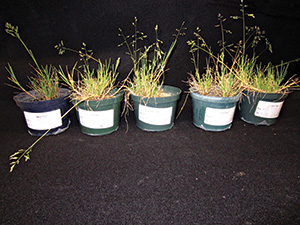Phosphorus fertilization effects on Poa annua
By Beth Guertal, Ph.D., and Scott McElroy, Ph.D.

A Poa annua plant fertilized with 200 lbs. P2O5 per acre. Photo: Beth Guertal, Ph.D., and Scott McElroy, Ph.D
Annual bluegrass (Poa annua L.) is a common and persistent winter annual weed in southern landscapes. Previous research has indicated that phosphorus (P) may affect populations of annual bluegrass. Thus, the objective of this work was to evaluate the effect of P rate on Poa annua, seeking management methods for reduction of Poa annua.
Conducted twice in the greenhouse, this study evaluated rates of P (0, 50, 100, 200 and 400 lbs. P2O5 per acre) applied to three soil types (sandy clay, loamy sand and a sand/peat mix), with five replications of each. Poa annua was seeded into each pot, and collected data included number of germinated seedlings, plant height, days to first seedhead, panicles per seedhead and variability in weight of seed produced.
In general, plant size and seed production increased as P rate increased, while days to maturity decreased. The addition of P decreased the number of days to maturity. Poa annua grown in the sand-peat mix was slower to produce a first seedhead, produced fewer seed with a lighter weight, and had fewer seedheads when compared to the two native soils. Overall, the addition of any P produced larger and more productive Poa annua.
Contact Beth Guertal, Ph.D., at guertea@auburn.edu or Scott McElroy, Ph.D., at jsm0010@auburn.edu at Auburn University for more information.








